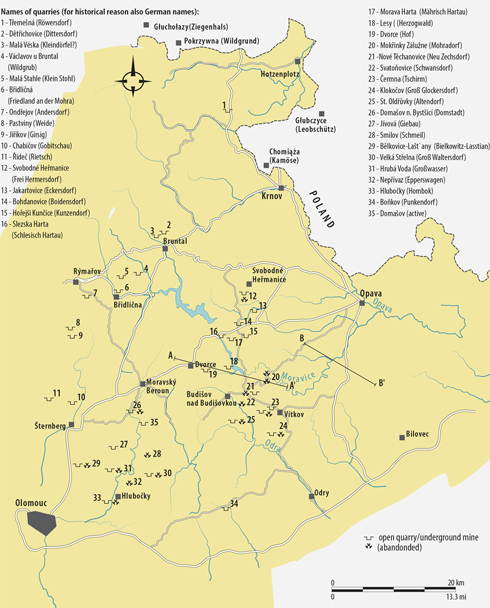|
Slate deposits of Moravia and Silesia [Czech Republic]
The slates of Moravia lie in the eastern part of the Czech republic, between Olomouc and Opava or Olomouc, Sternberk and Bruntal. The slates show a light grey colour with a partly occurring slight bluish shimmer and a rustic surface. Only small roofing slate slabs with a great thickness could be produced.
The area belongs to the eastern branch of the Middle European Variscan which is named 'Moravosilesian Zone' and builds the south-eastern edge of the Bohemian Massif (Walther, 1995). In the south-eastern part of the 'Moravosilesian Zone' the Moravian Kulm comprises the low mountains Drahansky Vrchovina and Nízký Jeseník.
According to the Geological map, the Moravian Kulm consist of Upper-Devonian and Lower-Carboniferous flysch series, comprising slates, sandstones and conglomerate bearing greywackes in which Tertiary volcanic rocks occasionally occur. The thickness of this series ranges between 18,700 ft. and 24,278 ft. and is devised in the Andelská Hora- , Benešov - , Moravice as well as Hradec-Kyjovice Formation (Dvorak, 1975). Except for the Benešovske Formation, the Moravian roofing slates are related to the Moravian Kulm.
The lithofacies and sedimentary structures of the Moravice Formation are very complex. They show deposits of high- and low density turbidites and possibly debris flows within the remnants of foreland basins (Mikulaš et al., 2002).
The tectonic setting is characterized by a NNE-SSW striking and relative simple moderate dipping fold style showing a west-vergency in the eastern part and an east-vergency in the eastern part. The intensity and age of folding and the metamorphism decrease from west to east: in the western part the Upper-Devonian units are deformed at the end of the Upper-Devonian whereas it was deformed probably at Namurian A/B in the east (Walter, 1995).
Abandoned slate quarries in Moravia

The fanning fracture cleavage is medium steep to steep (Kumpera, 1966) and seems to be only locally developed within the more muddy-siltic members. Within the more sandy coarse grained part the cleavage is only weakly developed and thus the bedding creates the main splitting plane.
Slate Types
Three different slate types can be distinguished in the Moravian district:
| Slate Type |
Slate Deposit (-mining) |
Description |
Blockschiefer
(Klotzschiefer) |
Hruba Voda
|
– fanning fracture cleavage with a distinct angle SS - S1
- thickness of slabs between 0.24 - 0.39 in.
- occur in the homogeneous pelitic units
-coarser layers can lead to a more pencil slate especially
since the cleavage is not well developed |
| Stockschiefer |
Nove Techanovice-Lhotka
Svatonovice |
– acute angle SS - S1 (2°-10°)
-can be considered as a transition between fanning fracture
cleavage and parallel cleavage
- occurs in rhythmic sediments of the Moravian Kulm (greywackes, sandstones, fine sandy and siltic slates, mudstones)
- fine sandy and siltic slates show a splitting parallel
to the bedding
- the appearance of the splitting plane is shell-like and the thickness of the shingles varies between 0.39 - 0.79 in. |
| Blattelschiefer |
no mining |
- splits only parallel to bedding and the thickness of the shingles varies between 0.20 - 0.39 in.
- occurs in fine bedded and probably 49 ft. thick slates
|
Regarding the active mining, the situation can quickly change. In 2016, the author was told that there exist plans to re-open a slate mine but it seems that all mines and quarries are still inactive.
Pictures
Move mouse over thumb to enlarge.
|

